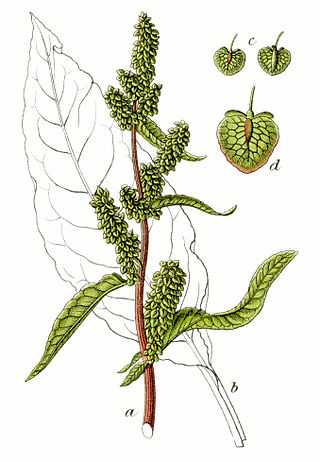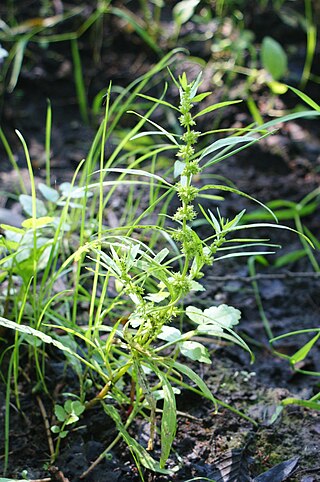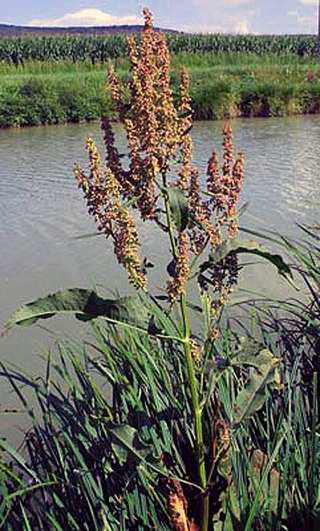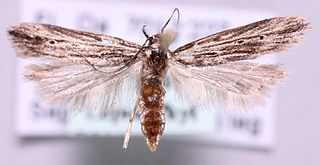
The Polygonaceae are a family of flowering plants known informally as the knotweed family or smartweed—buckwheat family in the United States. The name is based on the genus Polygonum, and was first used by Antoine Laurent de Jussieu in 1789 in his book, Genera Plantarum. The name may refer to the many swollen nodes the stems of some species have, being derived from Greek [poly meaning 'many' and gony meaning 'knee' or 'joint']. Alternatively, it may have a different origin, meaning 'many seeds'.

Sorrel, also called common sorrel or garden sorrel, is a perennial herbaceous plant in the family Polygonaceae. Other names for sorrel include spinach dock and narrow-leaved dock.

Rubella, also known as German measles or three-day measles, is an infection caused by the rubella virus. This disease is often mild, with half of people not realizing that they are infected. A rash may start around two weeks after exposure and last for three days. It usually starts on the face and spreads to the rest of the body. The rash is sometimes itchy and is not as bright as that of measles. Swollen lymph nodes are common and may last a few weeks. A fever, sore throat, and fatigue may also occur. Joint pain is common in adults. Complications may include bleeding problems, testicular swelling, encephalitis, and inflammation of nerves. Infection during early pregnancy may result in a miscarriage or a child born with congenital rubella syndrome (CRS). Symptoms of CRS manifest as problems with the eyes such as cataracts, deafness, as well as affecting the heart and brain. Problems are rare after the 20th week of pregnancy.

The docks and sorrels, genus Rumex, are a genus of about 200 species of annual, biennial, and perennial herbs in the buckwheat family, Polygonaceae. Members of this genus are very common perennial herbs with a native almost worldwide distribution, and introduced species growing in the few places where the genus is not native.

Rumex crispus, the curly dock, curled dock or yellow dock, is a perennial flowering plant in the family Polygonaceae, native to Europe and Western Asia.

Capsella is a genus of herbaceous plant and biennial plants in the family Brassicaceae. It is a close relative of Arabidopsis, Neslia, and Halimolobos.

Rumex obtusifolius, commonly known as bitter dock, broad-leaved dock, bluntleaf dock, dock leaf, dockens or butter dock, is a perennial plant in the family Polygonaceae. It is native to Europe, but is found on all temperate continents. It is a highly invasive species in some zones, resulting from its abundant seed dispersal, adaptability to reproduce, aggressive roots, ability to tolerate extreme climates, and hardiness.

Rumex acetosella, commonly known as red sorrel, sheep's sorrel, field sorrel and sour weed, is a species of flowering plant in the buckwheat family Polygonaceae. Native to Eurasia and the British Isles, the plant and its subspecies are common perennial weeds. It has green arrowhead-shaped leaves and red-tinted deeply ridged stems, and it sprouts from an aggressive and spreading rhizome. The flowers emerge from a tall, upright stem. Female flowers are maroon in color.
Ramularia cyclaminicola is a species of fungus in the family Mycosphaerellaceae. It is a plant pathogen that infects cyclamens.
Ramularia menthicola is a species of fungus in the family Mycosphaerellaceae. It is a plant pathogen that infects mint. It was formally described as a new species by the Italian mycologist Pier Andrea Saccardo in 1886. In his 1998 monograph on phytopathogenic Hyphomycetes, Uwe Braun suggests that Ramularia menthae should be considered a synonym to Ramularia lamii, but the name remains in use in the scientific literature, and is accepted as a valid species by Index Fungorum.

Rumex maritimus, commonly called golden dock, bristle dock, or seashore dock, is an annual plant species of the genus Rumex. Rumex maritimus grows in Argentina, Burma, Canada, China, and the United States. It is native to Canada and most of the 48 states. The life span of Rumex maritimus is rarely biennial in moist environments. This herb belongs to the family Polygonaceae.

Rumex palustris, or marsh dock, is a plant species of the genus Rumex, found in Europe. The species is a dicot belonging to the family Polygonaceae. The species epithet palustris is Latin for "of the marsh" which indicates its common habitat.

Mycosphaerella is a genus of ascomycota. With more than 10,000 species, it is the largest genus of plant pathogen fungi.

Rumex hydrolapathum, the great water dock, water dock, or giant water dock, is a species of perennial herbaceous plants in the genus Rumex native to fens and freshwater banks of Europe and Western Asia. It is the tallest species in the genus, with flowering stems attaining a height of up to 2 m. It is one of the small number of decaploid organisms, containing two hundred individual chromosomes.

Rumex patientia, known as patience dock, garden patience, herb patience, or monk's rhubarb, is a herbaceous perennial flowering plant belonging to the family Polygonaceae. In spring it is often consumed as a leaf vegetable and as a filling in pies in Southern Europe, especially in Bulgaria, North Macedonia, Bosnia and Herzegovina and Serbia. It is also used in Romania in spring broths or sarmale.

Ramularia is a genus of ascomycete fungi. Its species, which are anamorphs of the genus Mycosphaerella, are plant pathogens. Economically important host species include Narcissus, sugar beet, and barley.

Rumex salicifolius is a species of flowering perennial plant in the knotweed family known by the common names willow dock and willow-leaved dock. It is native to much of western North America, and more specifically, in southern and central parts of California, and some parts of Arizona and Nevada. It can also be found in parts of Europe as an introduced species and a roadside weed. It is an extremely variable plant which is generally divided into many varieties, some of which may actually be specimens of other species.

Monochroa palustrellus, the wainscot neb, is a moth of the family Gelechiidae. It is found in from western, central and northern Europe to the Ural Mountains and southern Siberia. The habitat consists of waste ground, dry pastures and sand-dunes.

Ramularia ulmariae is a fungal species described by Cooke in 1876. Ramularia ulmariae belongs to the genus Ramularia and the family Mycosphaerellaceae. No subspecies are listed in the Catalog of Life.

Rubellin B is a phytotoxic chemical responsible for the Ramularia leaf spot disease due to its ability to create reactive radical superoxides. The drug has not been involved in many clinical studies, but has been found to prevent tau aggregation pointing to its potential in the treatment of Alzheimer's disease.

















